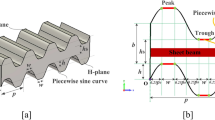Abstract
For high-power operation, a THz gyrotron traveling-wave-tube (gyro-TWT) amplifier must operate in a high-order waveguide mode to enlarge the transverse dimension of an interaction waveguide. However, a gyro-TWT amplifier operating in a high-order waveguide mode is susceptible to spurious oscillations. To improve the device stability, in this study, we investigate the possibility of using a coaxial waveguide with distributed losses as the interaction structure. For the same required attenuation, all threatening oscillating modes can be suppressed using different combinations of losses of inner and outer cylinders. This provides flexibility in designing distributed losses when considering the ohmic loading of the interaction structure. We predict that the 0.2-THz gyro-TWT can stably produce a peak power of 14 kW with an efficiency of 23 %, a 3-dB bandwidth of 3.5 GHz, and a saturated gain of 50 dB for a 20-kV 3-A electron beam with a 5 % velocity spread and 1.0 velocity ratio.












Similar content being viewed by others
References
K. R. Chu, H. Y. Chen, C. L. Hung, T. H. Chang, L. R. Barnett, S. H. Chen, T. T. Yang, and D. Dialetis, IEEE Trans. Plasma Sci. 27, 391 (1999).
M. Garven, J. P. Calame, B. G. Danly, K. T. Nguyen, B. Levush, F. N. Wood, and D. E. Pershing, IEEE Trans. Plasma Sci. 30, 885 (2002).
H. H. Song, D. B. McDermott, Y. Hirata, L. R. Barnett, C. W. Domier, H. L. Hsu, T. H. Chang, W. C Tsai, K. R. Chu, and N. C. Luhman, Jr., Phys. Plasmas 11, 2935 (2004).
B. Liu, J. Feng, E. Wang, Z. Li, X. Zeng, L. Qian, and H. Wang, IEEE Trans. Plasma Sci. 39, 1665 (2011).
E. Wang, X. Zeng, B. Liu, L. Qian, Z. Li, J. Feng, and S. Zhu, IEEE Trans. Plasma Sci. 40, 1846 (2012).
R. Yan, Y. Tang, and Y. Luo, IEEE Trans. Electron Devices 61, 2564 (2014).
J. R. Sirigiri, M. A. Shapiro, and R. J. Temkin, Phys. Rev. Lett. 90, 258302 (2003).
E. A. Nanni, S. M. Lewis, M. A. Shapiro, R. G. Griffin, and R. J. Temkin, Phys. Rev. Lett. 111, 25101 (2013).
S. N. Vlasov, L. I. Zagryadskaya, and I. M. Orlova, Radio Eng. and Electron. Phys. 21, 96 (1976).
C. L. Hung and N. H. Cheng, IEEE Tran. Electron Devices 61, 1812 (2014).
C. L. Hung, M. F. Syu, M. T. Yang, and K. L. Chen, Appl. Phys. Lett. 101, 033504 (2012).
C. L. Hung and Y. S. Yeh, Phys. Plasmas 12, 103102 (2005).
J. P. Calame, M. Garven, B. G. Danly, B. Levush, and K. T. Nguyen, IEEE Trans. Electron Devices 49, 1469 (2002).
I. G. Tigelis, J. L. Vomvoridis and S. Tzima, IEEE Trans. Plasma Sci. 26, 922 (1998).
C. H. Du, Q. Z. Xue, P. K. Liu, M. H. Wang, IEEE Transactions on Electron Devices 56, 839 (2009).
Acknowledgments
The authors would like to thank the National Science Council of the Republic of China, Taiwan, for financially supporting this research under Contract MOST 103-2221-E-346-001 and MOST 104-2221-E-346-001. We are grateful to the National Center for High-performance Computing for computer time and facilities.
Author information
Authors and Affiliations
Corresponding author
Rights and permissions
About this article
Cite this article
Hung, C.L., Yeh, Y.S., Chang, T.H. et al. A Stable 0.2-THz Coaxial-Waveguide Gyrotron Traveling-Wave-Tube Amplifier with Distributed Losses. J Infrared Milli Terahz Waves 38, 1–11 (2017). https://doi.org/10.1007/s10762-016-0302-9
Received:
Accepted:
Published:
Issue Date:
DOI: https://doi.org/10.1007/s10762-016-0302-9




